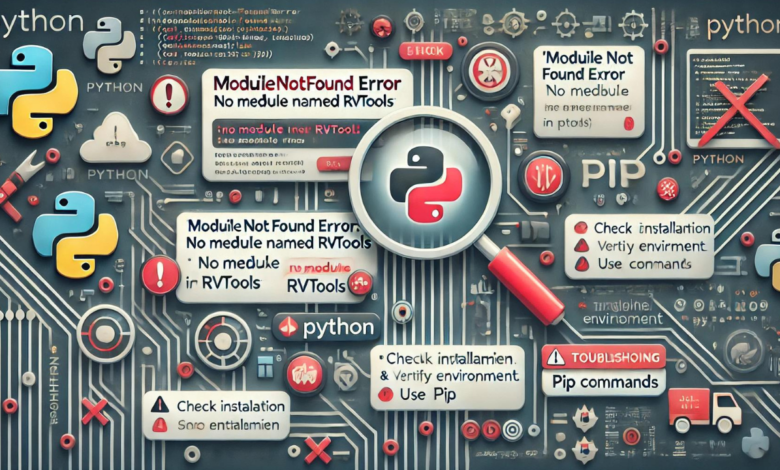Tackling the Dreaded ModuleNotFoundError: No module named ‘rvtools’

In Python programming, encountering errors is part and parcel of the development process. Among the myriad possible issues, one widespread yet frustrating problem is the “ModuleNotFoundError.” This article dives deep into one specific error: ModuleNotFoundError: No module named ‘rvtools’ We’ll explore its causes, solutions, and preventive measures to ensure smoother coding sessions for novice and seasoned developers.
What is ‘rvtools’?
Before dissecting the error, let’s understand what ‘rvtools‘ refers to. ‘rvtools’ is a hypothetical Python library for data manipulation and visualization. It’s a tool that could be integral in data science and machine learning projects, providing functionalities to ease data analysis and enhance data presentation. However, as of now, ‘rvtools’ does not correspond to an actual, publicly available Python library, which is central to understanding and resolving the error discussed here.
Decoding the Error
The ModuleNotFoundError is a specific exception that is raised when Python cannot locate a module. A “No module named ‘tools'” error pops up when Python’s interpreter fails to find the ‘tools’ library in the environment’s path. This could stem from several scenarios:
- Typographical Errors: The module name is mistyped in the import statement.
- Installation Issues: Not having the module installed in the Python environment being used.
- Environment Confusion: Using a different Python environment where the module isn’t installed is often the case with multiple virtual environments.
Step-by-Step Solutions
Verify the Module Name
First, ensure the module name in your import statement is accurate. Even minor typos can cause this error.
Installation Check
If the module name is correct, the next step is to check if it’s installed:
If you receive no information about the module, it’s not installed in your environment.
Installing ‘rvtools’
To install the module, use pip, Python’s package manager:
Note: Replace ‘rvtools’ with the correct module name you intend to use.
Environment Verification
Ensure that your script is running in the correct Python environment:
This command helps verify that the script uses the intended Python interpreter.
Update pip
An outdated pip can sometimes lead to issues when installing packages:
Alternative Package Managers
If pip fails, consider using Conda or another package manager that might resolve dependency conflicts more effectively.
Preventive Measures
- Virtual Environments: Utilize virtual environments to manage dependencies separately for different projects.
- Requirements File: Maintain a requirements.txt file for your projects to keep track of all necessary packages.
- Regular Updates: Keep your packages and pip updated to avoid compatibility issues.
Conclusion
The ModuleNotFoundError: No module named ‘rvtools’ error, while common, is generally straightforward to fix with proper naming, installation, and environment management practices. By following the detailed steps outlined above, developers can mitigate such errors and focus more on productivity and less on troubleshooting.
FAQs
What is a ModuleNotFoundError in Python?
A ModuleNotFoundError is raised when Python cannot locate an imported module in the current environment’s path. This error is specific to Python and indicates issues with module installation or environment configurations.
What are virtual environments, and how can they help?
Virtual environments in Python allow you to manage separate package installations for different projects. By using virtual environments, you can avoid conflicts between package versions and ensure that dependencies required by specific projects are isolated and manageable.
Are there alternative tools to ‘rvtools’ for data manipulation and visualization?
Yes, if ‘rvtools’ does not suit your needs or if you’re looking for alternatives, libraries like Matplotlib, Seaborn, and Pandas are excellent for data visualization and manipulation in Python.
What should I do if I still can’t resolve the error?
Explore online forums like Stack Overflow or consult the Python community for more specific guidance tailored to your situation.
How can I prevent such issues in the future?
Consistent use of virtual environments and adherence to best practices in package management can significantly reduce the likelihood of such errors.
You May Also Read: Troubleshooting the Avocent UMG 4000 Webpage 127.0.0.1:8128 Cannot Load




